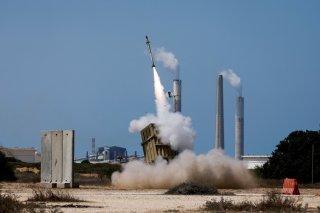Can the Pentagon’s ‘Layered Defense’ Shoot Down Hypersonic Missiles?
The MDA has now awarded concept and design GPI deals to Raytheon, Lockheed, and Northrop Grumman to strengthen what agency officials describe as a “layered defense.”
A Navy warship may be able to fire an interceptor from its Vertical Launch Systems fast enough and far enough to destroy an attacking hypersonic weapon traveling at five times the speed of sound. This is the goal of the Pentagon’s ambitious and fast-moving Glide Phase Interceptor program, a high-tech effort intended to introduce a paradigm-changing ability to take out seemingly impossible to defend hypersonics.
Early conceptual and computer simulation work on the Glide Phase Interceptor is being done in coordination with an emerging technology called Hypersonic and Ballistic Tracking Space Sensor (HTBSS).
HBTSS is designed to leverage a growing network of new smaller, lower-altitude Low and Medium Earth Orbit Satellites operating as a “meshed” network of extended, long-range nodes able to transmit target track specifics in real-time. The idea is to track otherwise “beyond-line-of-sight” targets enabling fire control to establish and maintain a track early in the weapons launch, striking it just before its descent.
“HBTSS is on the path to launch two interoperable satellites that are built by two separate industry partners. So the idea is to keep competition in early, given the complexity of the mission. It is the only program within the space portfolio that provides fire control quality data down to a weapon system like Glide Phase Interceptor,” Navy Vice Adm. Jon Hill, director of the Missile Defense Agency (MDA), told reporters last year, according to a Pentagon transcript.
The MDA has now awarded concept and design GPI deals to Raytheon, Lockheed, and Northrop Grumman to strengthen what agency officials describe as a “layered defense.” HBTSS could help find targets for the GPI and potentially pass them along in seconds while a hypersonic missile is traveling to its target.
“The GPI concept fits into the MDA's missile defense architecture to provide the warfighter and its allies with reliable layered defense against regional hypersonic missile threats from rogue-nations,” an MDA statement said.
The GPIs are being slated to fire from ship-integrated Vertical Launch Systems using Aegis weapons systems. Yet, the targeting details can first come from space sensors such as HBTSS, which Northrop Grumman developers describe as an “integrated constellation.”
Kris Osborn is the defense editor for the National Interest. Osborn previously served at the Pentagon as a Highly Qualified Expert with the Office of the Assistant Secretary of the Army—Acquisition, Logistics & Technology. Osborn has also worked as an anchor and on-air military specialist at national TV networks. He has appeared as a guest military expert on Fox News, MSNBC, The Military Channel, and The History Channel. He also has a Master’s Degree in Comparative Literature from Columbia University.
Image: Reuters.

